Nike Assignment 2022
VerifiedAdded on 2022/10/17
|9
|2208
|14
Assignment
AI Summary
Contribute Materials
Your contribution can guide someone’s learning journey. Share your
documents today.

Running head: NIKE 1
Nike
Name
Institution
Nike
Name
Institution
Secure Best Marks with AI Grader
Need help grading? Try our AI Grader for instant feedback on your assignments.
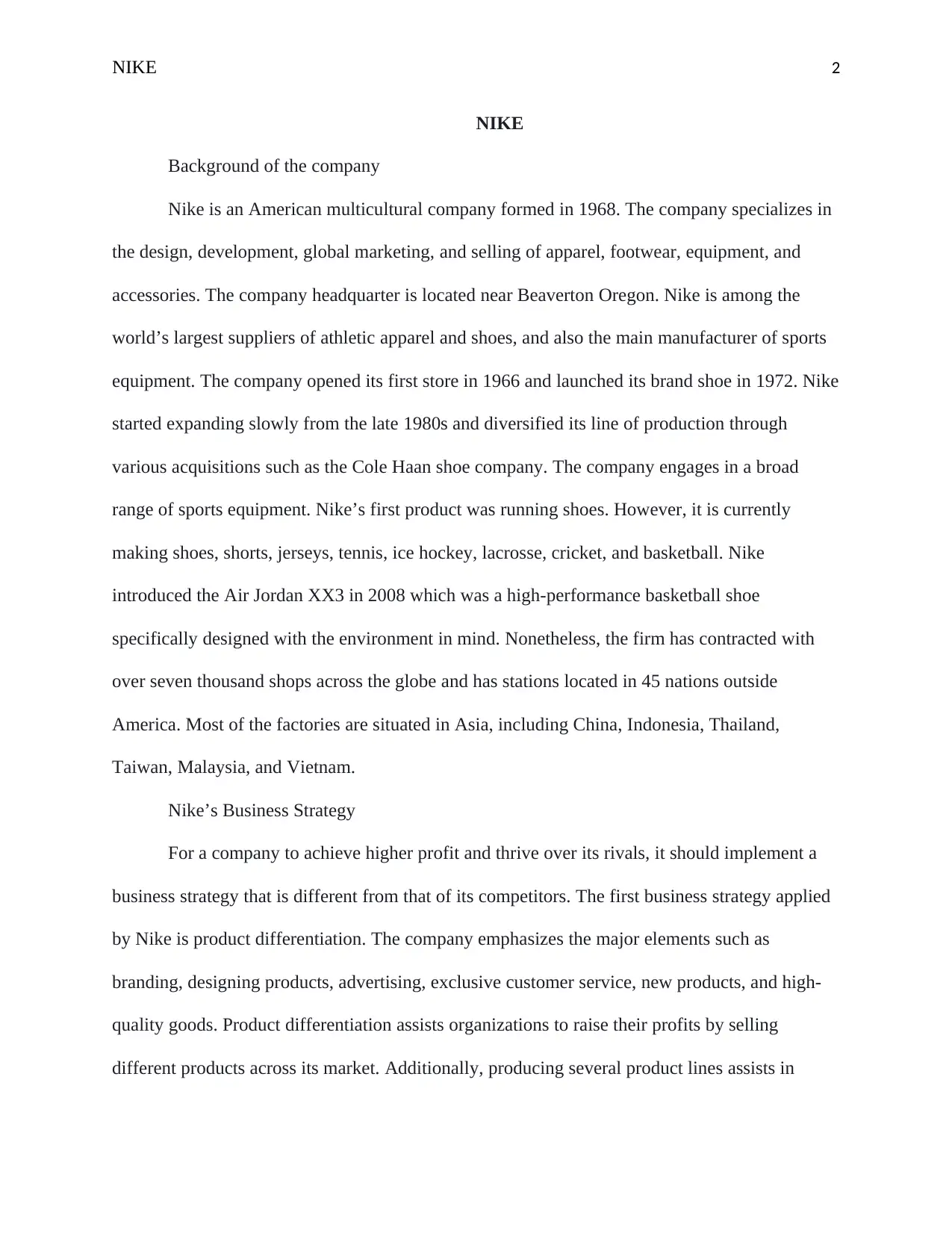
NIKE 2
NIKE
Background of the company
Nike is an American multicultural company formed in 1968. The company specializes in
the design, development, global marketing, and selling of apparel, footwear, equipment, and
accessories. The company headquarter is located near Beaverton Oregon. Nike is among the
world’s largest suppliers of athletic apparel and shoes, and also the main manufacturer of sports
equipment. The company opened its first store in 1966 and launched its brand shoe in 1972. Nike
started expanding slowly from the late 1980s and diversified its line of production through
various acquisitions such as the Cole Haan shoe company. The company engages in a broad
range of sports equipment. Nike’s first product was running shoes. However, it is currently
making shoes, shorts, jerseys, tennis, ice hockey, lacrosse, cricket, and basketball. Nike
introduced the Air Jordan XX3 in 2008 which was a high-performance basketball shoe
specifically designed with the environment in mind. Nonetheless, the firm has contracted with
over seven thousand shops across the globe and has stations located in 45 nations outside
America. Most of the factories are situated in Asia, including China, Indonesia, Thailand,
Taiwan, Malaysia, and Vietnam.
Nike’s Business Strategy
For a company to achieve higher profit and thrive over its rivals, it should implement a
business strategy that is different from that of its competitors. The first business strategy applied
by Nike is product differentiation. The company emphasizes the major elements such as
branding, designing products, advertising, exclusive customer service, new products, and high-
quality goods. Product differentiation assists organizations to raise their profits by selling
different products across its market. Additionally, producing several product lines assists in
NIKE
Background of the company
Nike is an American multicultural company formed in 1968. The company specializes in
the design, development, global marketing, and selling of apparel, footwear, equipment, and
accessories. The company headquarter is located near Beaverton Oregon. Nike is among the
world’s largest suppliers of athletic apparel and shoes, and also the main manufacturer of sports
equipment. The company opened its first store in 1966 and launched its brand shoe in 1972. Nike
started expanding slowly from the late 1980s and diversified its line of production through
various acquisitions such as the Cole Haan shoe company. The company engages in a broad
range of sports equipment. Nike’s first product was running shoes. However, it is currently
making shoes, shorts, jerseys, tennis, ice hockey, lacrosse, cricket, and basketball. Nike
introduced the Air Jordan XX3 in 2008 which was a high-performance basketball shoe
specifically designed with the environment in mind. Nonetheless, the firm has contracted with
over seven thousand shops across the globe and has stations located in 45 nations outside
America. Most of the factories are situated in Asia, including China, Indonesia, Thailand,
Taiwan, Malaysia, and Vietnam.
Nike’s Business Strategy
For a company to achieve higher profit and thrive over its rivals, it should implement a
business strategy that is different from that of its competitors. The first business strategy applied
by Nike is product differentiation. The company emphasizes the major elements such as
branding, designing products, advertising, exclusive customer service, new products, and high-
quality goods. Product differentiation assists organizations to raise their profits by selling
different products across its market. Additionally, producing several product lines assists in
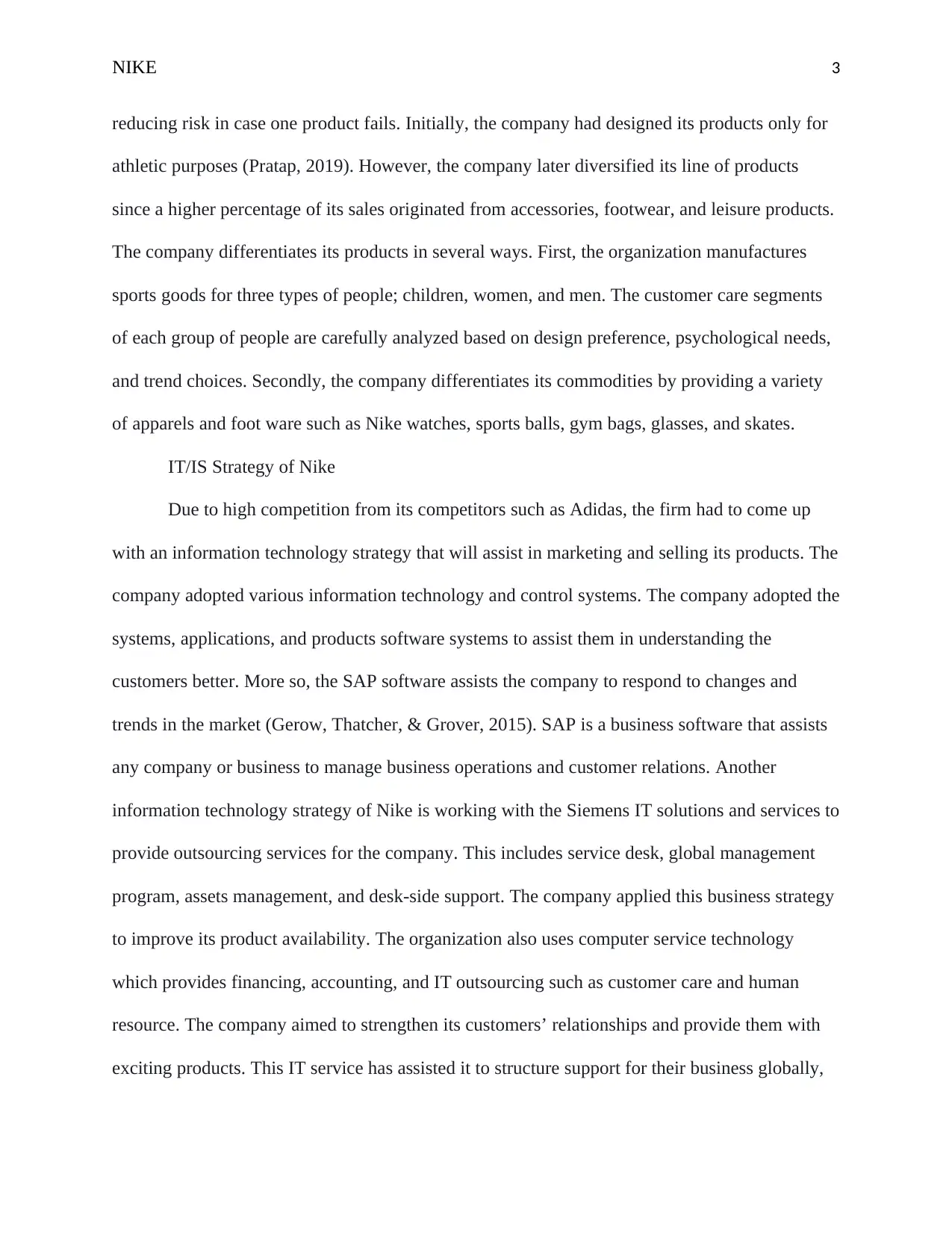
NIKE 3
reducing risk in case one product fails. Initially, the company had designed its products only for
athletic purposes (Pratap, 2019). However, the company later diversified its line of products
since a higher percentage of its sales originated from accessories, footwear, and leisure products.
The company differentiates its products in several ways. First, the organization manufactures
sports goods for three types of people; children, women, and men. The customer care segments
of each group of people are carefully analyzed based on design preference, psychological needs,
and trend choices. Secondly, the company differentiates its commodities by providing a variety
of apparels and foot ware such as Nike watches, sports balls, gym bags, glasses, and skates.
IT/IS Strategy of Nike
Due to high competition from its competitors such as Adidas, the firm had to come up
with an information technology strategy that will assist in marketing and selling its products. The
company adopted various information technology and control systems. The company adopted the
systems, applications, and products software systems to assist them in understanding the
customers better. More so, the SAP software assists the company to respond to changes and
trends in the market (Gerow, Thatcher, & Grover, 2015). SAP is a business software that assists
any company or business to manage business operations and customer relations. Another
information technology strategy of Nike is working with the Siemens IT solutions and services to
provide outsourcing services for the company. This includes service desk, global management
program, assets management, and desk-side support. The company applied this business strategy
to improve its product availability. The organization also uses computer service technology
which provides financing, accounting, and IT outsourcing such as customer care and human
resource. The company aimed to strengthen its customers’ relationships and provide them with
exciting products. This IT service has assisted it to structure support for their business globally,
reducing risk in case one product fails. Initially, the company had designed its products only for
athletic purposes (Pratap, 2019). However, the company later diversified its line of products
since a higher percentage of its sales originated from accessories, footwear, and leisure products.
The company differentiates its products in several ways. First, the organization manufactures
sports goods for three types of people; children, women, and men. The customer care segments
of each group of people are carefully analyzed based on design preference, psychological needs,
and trend choices. Secondly, the company differentiates its commodities by providing a variety
of apparels and foot ware such as Nike watches, sports balls, gym bags, glasses, and skates.
IT/IS Strategy of Nike
Due to high competition from its competitors such as Adidas, the firm had to come up
with an information technology strategy that will assist in marketing and selling its products. The
company adopted various information technology and control systems. The company adopted the
systems, applications, and products software systems to assist them in understanding the
customers better. More so, the SAP software assists the company to respond to changes and
trends in the market (Gerow, Thatcher, & Grover, 2015). SAP is a business software that assists
any company or business to manage business operations and customer relations. Another
information technology strategy of Nike is working with the Siemens IT solutions and services to
provide outsourcing services for the company. This includes service desk, global management
program, assets management, and desk-side support. The company applied this business strategy
to improve its product availability. The organization also uses computer service technology
which provides financing, accounting, and IT outsourcing such as customer care and human
resource. The company aimed to strengthen its customers’ relationships and provide them with
exciting products. This IT service has assisted it to structure support for their business globally,
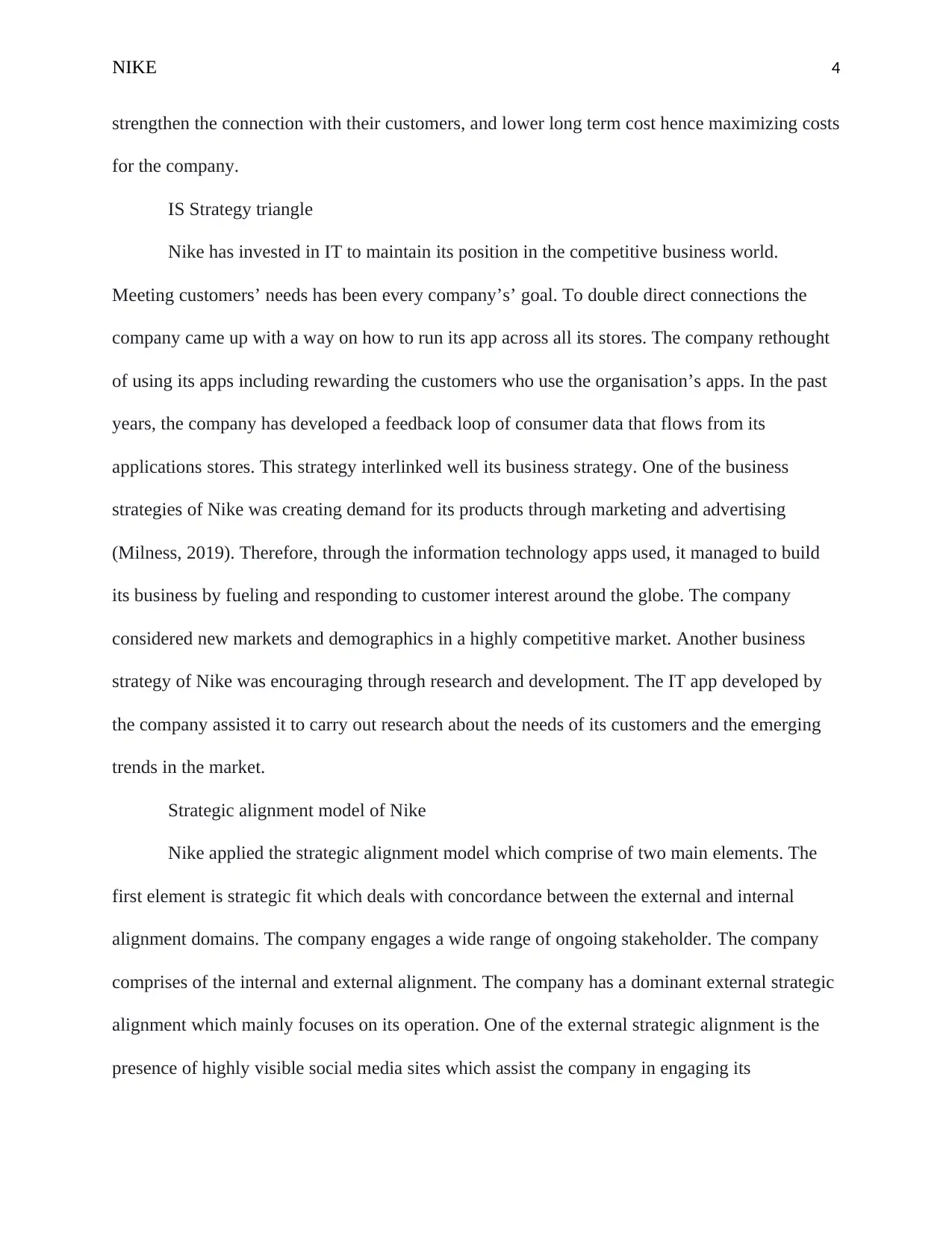
NIKE 4
strengthen the connection with their customers, and lower long term cost hence maximizing costs
for the company.
IS Strategy triangle
Nike has invested in IT to maintain its position in the competitive business world.
Meeting customers’ needs has been every company’s’ goal. To double direct connections the
company came up with a way on how to run its app across all its stores. The company rethought
of using its apps including rewarding the customers who use the organisation’s apps. In the past
years, the company has developed a feedback loop of consumer data that flows from its
applications stores. This strategy interlinked well its business strategy. One of the business
strategies of Nike was creating demand for its products through marketing and advertising
(Milness, 2019). Therefore, through the information technology apps used, it managed to build
its business by fueling and responding to customer interest around the globe. The company
considered new markets and demographics in a highly competitive market. Another business
strategy of Nike was encouraging through research and development. The IT app developed by
the company assisted it to carry out research about the needs of its customers and the emerging
trends in the market.
Strategic alignment model of Nike
Nike applied the strategic alignment model which comprise of two main elements. The
first element is strategic fit which deals with concordance between the external and internal
alignment domains. The company engages a wide range of ongoing stakeholder. The company
comprises of the internal and external alignment. The company has a dominant external strategic
alignment which mainly focuses on its operation. One of the external strategic alignment is the
presence of highly visible social media sites which assist the company in engaging its
strengthen the connection with their customers, and lower long term cost hence maximizing costs
for the company.
IS Strategy triangle
Nike has invested in IT to maintain its position in the competitive business world.
Meeting customers’ needs has been every company’s’ goal. To double direct connections the
company came up with a way on how to run its app across all its stores. The company rethought
of using its apps including rewarding the customers who use the organisation’s apps. In the past
years, the company has developed a feedback loop of consumer data that flows from its
applications stores. This strategy interlinked well its business strategy. One of the business
strategies of Nike was creating demand for its products through marketing and advertising
(Milness, 2019). Therefore, through the information technology apps used, it managed to build
its business by fueling and responding to customer interest around the globe. The company
considered new markets and demographics in a highly competitive market. Another business
strategy of Nike was encouraging through research and development. The IT app developed by
the company assisted it to carry out research about the needs of its customers and the emerging
trends in the market.
Strategic alignment model of Nike
Nike applied the strategic alignment model which comprise of two main elements. The
first element is strategic fit which deals with concordance between the external and internal
alignment domains. The company engages a wide range of ongoing stakeholder. The company
comprises of the internal and external alignment. The company has a dominant external strategic
alignment which mainly focuses on its operation. One of the external strategic alignment is the
presence of highly visible social media sites which assist the company in engaging its
Secure Best Marks with AI Grader
Need help grading? Try our AI Grader for instant feedback on your assignments.
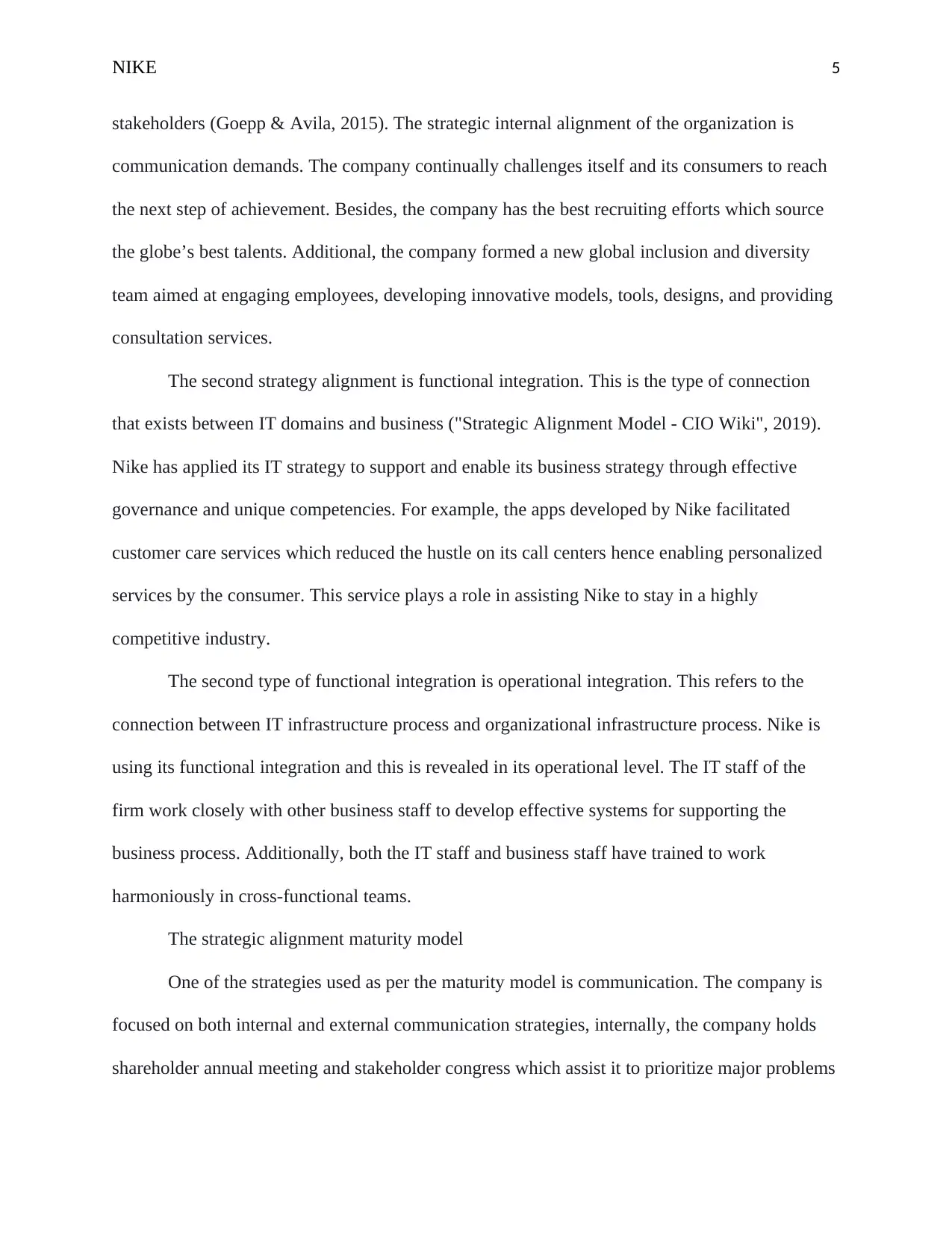
NIKE 5
stakeholders (Goepp & Avila, 2015). The strategic internal alignment of the organization is
communication demands. The company continually challenges itself and its consumers to reach
the next step of achievement. Besides, the company has the best recruiting efforts which source
the globe’s best talents. Additional, the company formed a new global inclusion and diversity
team aimed at engaging employees, developing innovative models, tools, designs, and providing
consultation services.
The second strategy alignment is functional integration. This is the type of connection
that exists between IT domains and business ("Strategic Alignment Model - CIO Wiki", 2019).
Nike has applied its IT strategy to support and enable its business strategy through effective
governance and unique competencies. For example, the apps developed by Nike facilitated
customer care services which reduced the hustle on its call centers hence enabling personalized
services by the consumer. This service plays a role in assisting Nike to stay in a highly
competitive industry.
The second type of functional integration is operational integration. This refers to the
connection between IT infrastructure process and organizational infrastructure process. Nike is
using its functional integration and this is revealed in its operational level. The IT staff of the
firm work closely with other business staff to develop effective systems for supporting the
business process. Additionally, both the IT staff and business staff have trained to work
harmoniously in cross-functional teams.
The strategic alignment maturity model
One of the strategies used as per the maturity model is communication. The company is
focused on both internal and external communication strategies, internally, the company holds
shareholder annual meeting and stakeholder congress which assist it to prioritize major problems
stakeholders (Goepp & Avila, 2015). The strategic internal alignment of the organization is
communication demands. The company continually challenges itself and its consumers to reach
the next step of achievement. Besides, the company has the best recruiting efforts which source
the globe’s best talents. Additional, the company formed a new global inclusion and diversity
team aimed at engaging employees, developing innovative models, tools, designs, and providing
consultation services.
The second strategy alignment is functional integration. This is the type of connection
that exists between IT domains and business ("Strategic Alignment Model - CIO Wiki", 2019).
Nike has applied its IT strategy to support and enable its business strategy through effective
governance and unique competencies. For example, the apps developed by Nike facilitated
customer care services which reduced the hustle on its call centers hence enabling personalized
services by the consumer. This service plays a role in assisting Nike to stay in a highly
competitive industry.
The second type of functional integration is operational integration. This refers to the
connection between IT infrastructure process and organizational infrastructure process. Nike is
using its functional integration and this is revealed in its operational level. The IT staff of the
firm work closely with other business staff to develop effective systems for supporting the
business process. Additionally, both the IT staff and business staff have trained to work
harmoniously in cross-functional teams.
The strategic alignment maturity model
One of the strategies used as per the maturity model is communication. The company is
focused on both internal and external communication strategies, internally, the company holds
shareholder annual meeting and stakeholder congress which assist it to prioritize major problems
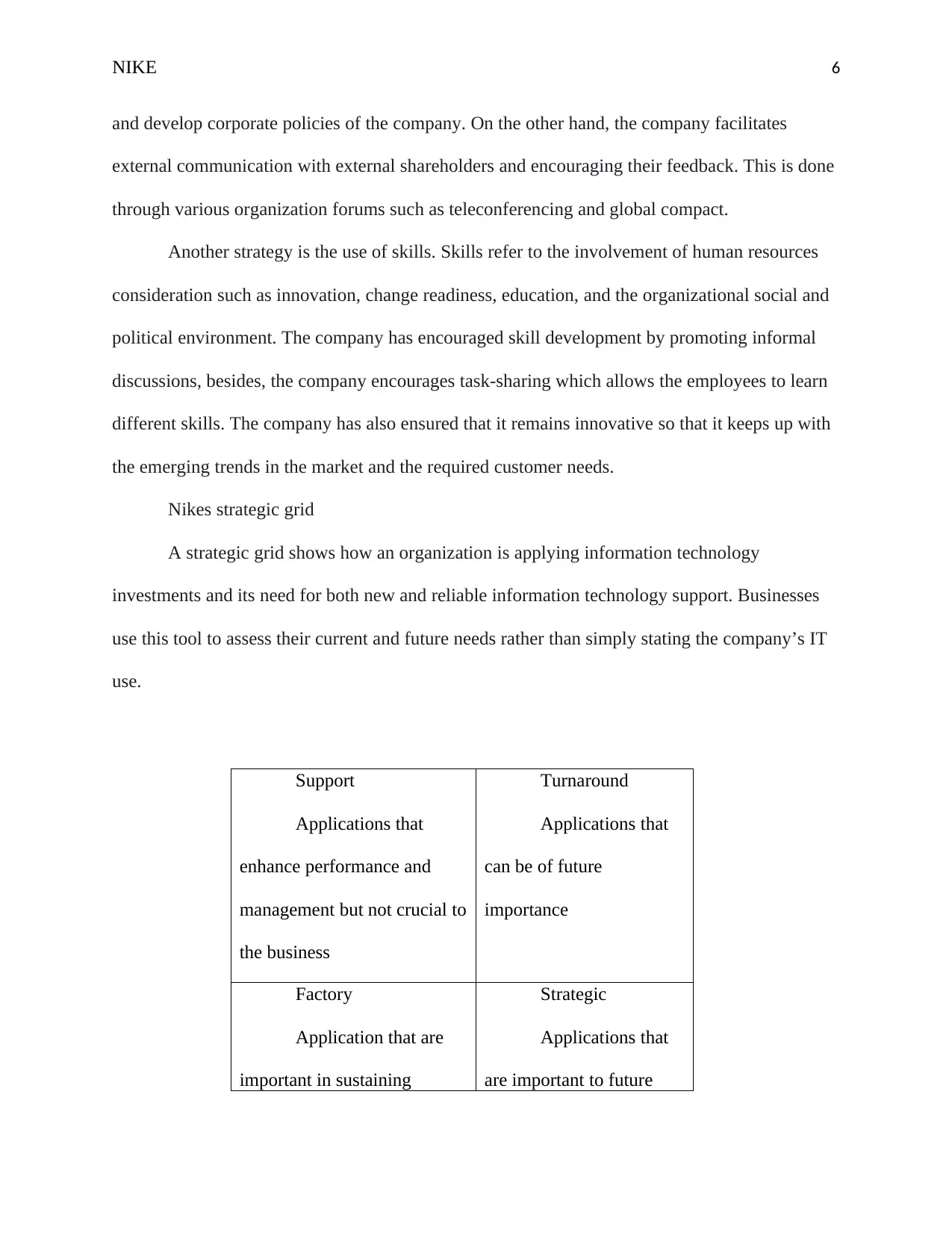
NIKE 6
and develop corporate policies of the company. On the other hand, the company facilitates
external communication with external shareholders and encouraging their feedback. This is done
through various organization forums such as teleconferencing and global compact.
Another strategy is the use of skills. Skills refer to the involvement of human resources
consideration such as innovation, change readiness, education, and the organizational social and
political environment. The company has encouraged skill development by promoting informal
discussions, besides, the company encourages task-sharing which allows the employees to learn
different skills. The company has also ensured that it remains innovative so that it keeps up with
the emerging trends in the market and the required customer needs.
Nikes strategic grid
A strategic grid shows how an organization is applying information technology
investments and its need for both new and reliable information technology support. Businesses
use this tool to assess their current and future needs rather than simply stating the company’s IT
use.
Support
Applications that
enhance performance and
management but not crucial to
the business
Turnaround
Applications that
can be of future
importance
Factory
Application that are
important in sustaining
Strategic
Applications that
are important to future
and develop corporate policies of the company. On the other hand, the company facilitates
external communication with external shareholders and encouraging their feedback. This is done
through various organization forums such as teleconferencing and global compact.
Another strategy is the use of skills. Skills refer to the involvement of human resources
consideration such as innovation, change readiness, education, and the organizational social and
political environment. The company has encouraged skill development by promoting informal
discussions, besides, the company encourages task-sharing which allows the employees to learn
different skills. The company has also ensured that it remains innovative so that it keeps up with
the emerging trends in the market and the required customer needs.
Nikes strategic grid
A strategic grid shows how an organization is applying information technology
investments and its need for both new and reliable information technology support. Businesses
use this tool to assess their current and future needs rather than simply stating the company’s IT
use.
Support
Applications that
enhance performance and
management but not crucial to
the business
Turnaround
Applications that
can be of future
importance
Factory
Application that are
important in sustaining
Strategic
Applications that
are important to future
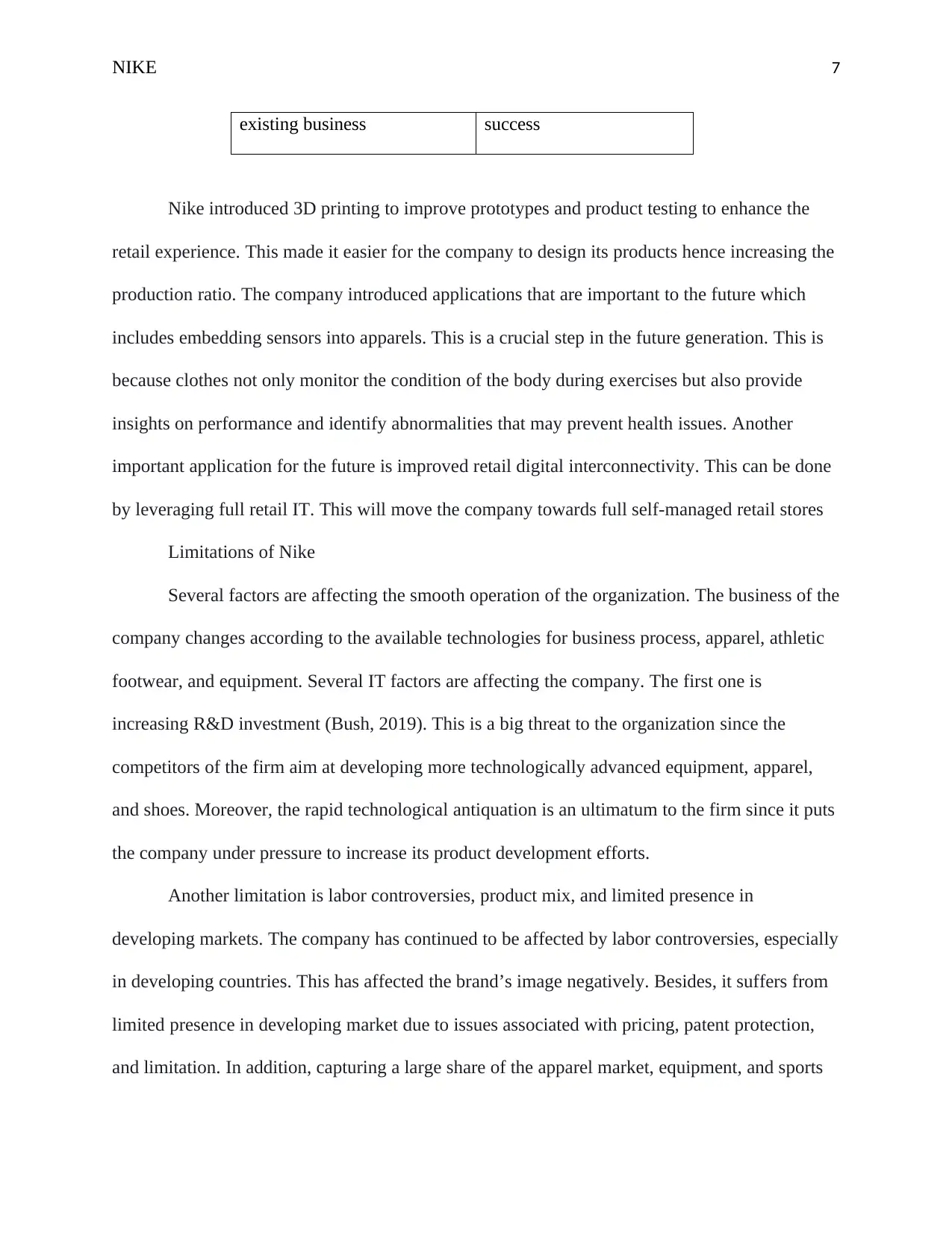
NIKE 7
existing business success
Nike introduced 3D printing to improve prototypes and product testing to enhance the
retail experience. This made it easier for the company to design its products hence increasing the
production ratio. The company introduced applications that are important to the future which
includes embedding sensors into apparels. This is a crucial step in the future generation. This is
because clothes not only monitor the condition of the body during exercises but also provide
insights on performance and identify abnormalities that may prevent health issues. Another
important application for the future is improved retail digital interconnectivity. This can be done
by leveraging full retail IT. This will move the company towards full self-managed retail stores
Limitations of Nike
Several factors are affecting the smooth operation of the organization. The business of the
company changes according to the available technologies for business process, apparel, athletic
footwear, and equipment. Several IT factors are affecting the company. The first one is
increasing R&D investment (Bush, 2019). This is a big threat to the organization since the
competitors of the firm aim at developing more technologically advanced equipment, apparel,
and shoes. Moreover, the rapid technological antiquation is an ultimatum to the firm since it puts
the company under pressure to increase its product development efforts.
Another limitation is labor controversies, product mix, and limited presence in
developing markets. The company has continued to be affected by labor controversies, especially
in developing countries. This has affected the brand’s image negatively. Besides, it suffers from
limited presence in developing market due to issues associated with pricing, patent protection,
and limitation. In addition, capturing a large share of the apparel market, equipment, and sports
existing business success
Nike introduced 3D printing to improve prototypes and product testing to enhance the
retail experience. This made it easier for the company to design its products hence increasing the
production ratio. The company introduced applications that are important to the future which
includes embedding sensors into apparels. This is a crucial step in the future generation. This is
because clothes not only monitor the condition of the body during exercises but also provide
insights on performance and identify abnormalities that may prevent health issues. Another
important application for the future is improved retail digital interconnectivity. This can be done
by leveraging full retail IT. This will move the company towards full self-managed retail stores
Limitations of Nike
Several factors are affecting the smooth operation of the organization. The business of the
company changes according to the available technologies for business process, apparel, athletic
footwear, and equipment. Several IT factors are affecting the company. The first one is
increasing R&D investment (Bush, 2019). This is a big threat to the organization since the
competitors of the firm aim at developing more technologically advanced equipment, apparel,
and shoes. Moreover, the rapid technological antiquation is an ultimatum to the firm since it puts
the company under pressure to increase its product development efforts.
Another limitation is labor controversies, product mix, and limited presence in
developing markets. The company has continued to be affected by labor controversies, especially
in developing countries. This has affected the brand’s image negatively. Besides, it suffers from
limited presence in developing market due to issues associated with pricing, patent protection,
and limitation. In addition, capturing a large share of the apparel market, equipment, and sports
Paraphrase This Document
Need a fresh take? Get an instant paraphrase of this document with our AI Paraphraser
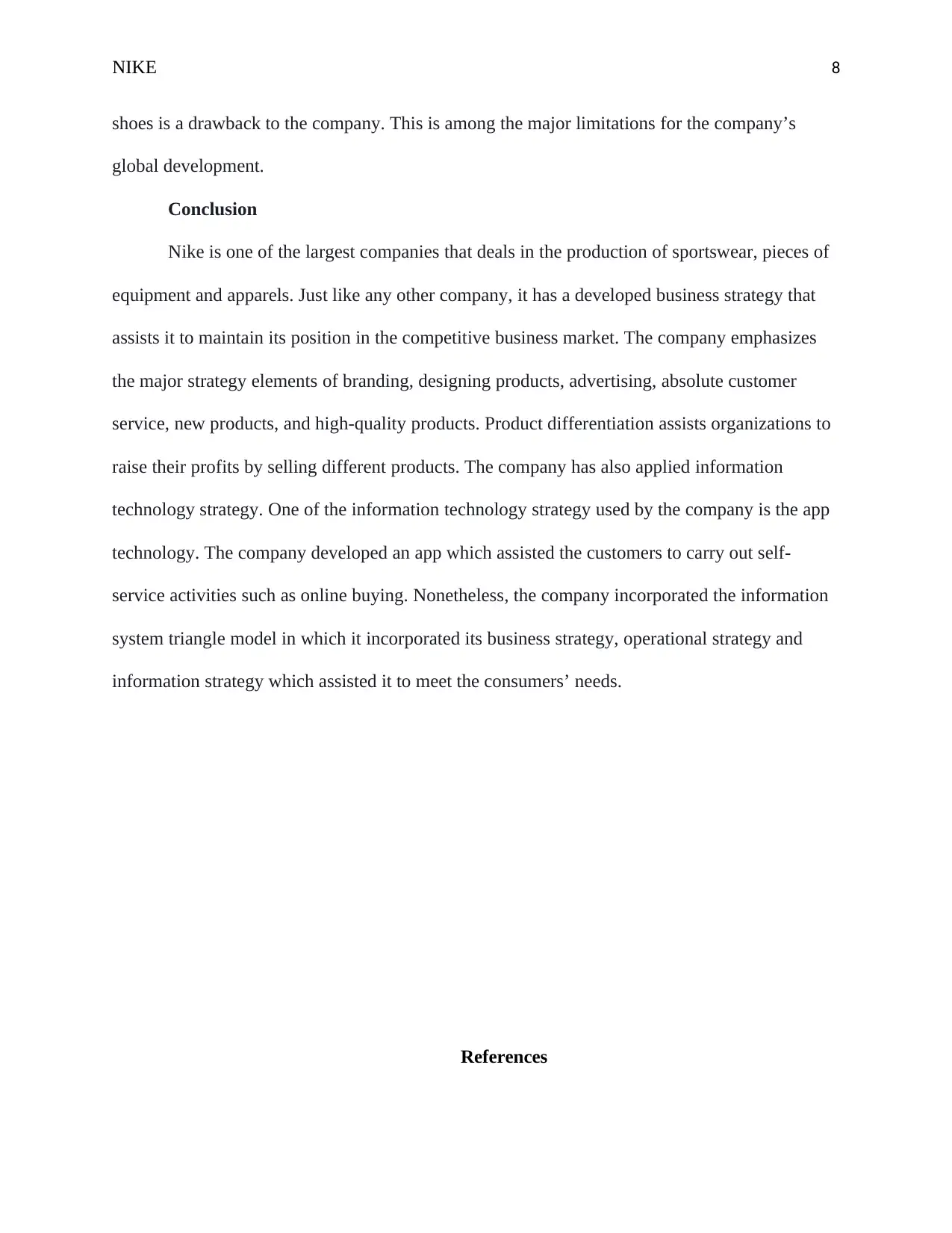
NIKE 8
shoes is a drawback to the company. This is among the major limitations for the company’s
global development.
Conclusion
Nike is one of the largest companies that deals in the production of sportswear, pieces of
equipment and apparels. Just like any other company, it has a developed business strategy that
assists it to maintain its position in the competitive business market. The company emphasizes
the major strategy elements of branding, designing products, advertising, absolute customer
service, new products, and high-quality products. Product differentiation assists organizations to
raise their profits by selling different products. The company has also applied information
technology strategy. One of the information technology strategy used by the company is the app
technology. The company developed an app which assisted the customers to carry out self-
service activities such as online buying. Nonetheless, the company incorporated the information
system triangle model in which it incorporated its business strategy, operational strategy and
information strategy which assisted it to meet the consumers’ needs.
References
shoes is a drawback to the company. This is among the major limitations for the company’s
global development.
Conclusion
Nike is one of the largest companies that deals in the production of sportswear, pieces of
equipment and apparels. Just like any other company, it has a developed business strategy that
assists it to maintain its position in the competitive business market. The company emphasizes
the major strategy elements of branding, designing products, advertising, absolute customer
service, new products, and high-quality products. Product differentiation assists organizations to
raise their profits by selling different products. The company has also applied information
technology strategy. One of the information technology strategy used by the company is the app
technology. The company developed an app which assisted the customers to carry out self-
service activities such as online buying. Nonetheless, the company incorporated the information
system triangle model in which it incorporated its business strategy, operational strategy and
information strategy which assisted it to meet the consumers’ needs.
References
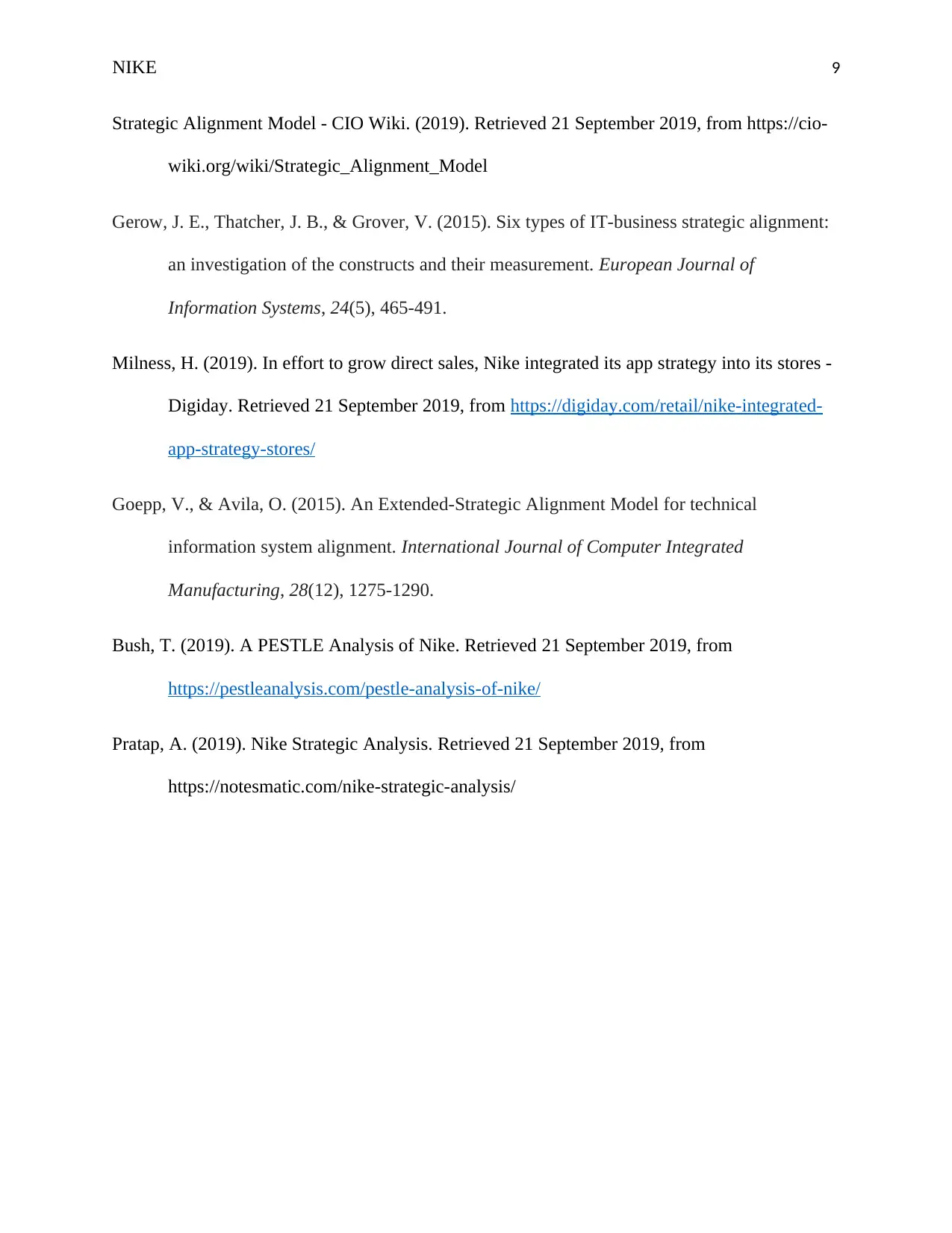
NIKE 9
Strategic Alignment Model - CIO Wiki. (2019). Retrieved 21 September 2019, from https://cio-
wiki.org/wiki/Strategic_Alignment_Model
Gerow, J. E., Thatcher, J. B., & Grover, V. (2015). Six types of IT-business strategic alignment:
an investigation of the constructs and their measurement. European Journal of
Information Systems, 24(5), 465-491.
Milness, H. (2019). In effort to grow direct sales, Nike integrated its app strategy into its stores -
Digiday. Retrieved 21 September 2019, from https://digiday.com/retail/nike-integrated-
app-strategy-stores/
Goepp, V., & Avila, O. (2015). An Extended-Strategic Alignment Model for technical
information system alignment. International Journal of Computer Integrated
Manufacturing, 28(12), 1275-1290.
Bush, T. (2019). A PESTLE Analysis of Nike. Retrieved 21 September 2019, from
https://pestleanalysis.com/pestle-analysis-of-nike/
Pratap, A. (2019). Nike Strategic Analysis. Retrieved 21 September 2019, from
https://notesmatic.com/nike-strategic-analysis/
Strategic Alignment Model - CIO Wiki. (2019). Retrieved 21 September 2019, from https://cio-
wiki.org/wiki/Strategic_Alignment_Model
Gerow, J. E., Thatcher, J. B., & Grover, V. (2015). Six types of IT-business strategic alignment:
an investigation of the constructs and their measurement. European Journal of
Information Systems, 24(5), 465-491.
Milness, H. (2019). In effort to grow direct sales, Nike integrated its app strategy into its stores -
Digiday. Retrieved 21 September 2019, from https://digiday.com/retail/nike-integrated-
app-strategy-stores/
Goepp, V., & Avila, O. (2015). An Extended-Strategic Alignment Model for technical
information system alignment. International Journal of Computer Integrated
Manufacturing, 28(12), 1275-1290.
Bush, T. (2019). A PESTLE Analysis of Nike. Retrieved 21 September 2019, from
https://pestleanalysis.com/pestle-analysis-of-nike/
Pratap, A. (2019). Nike Strategic Analysis. Retrieved 21 September 2019, from
https://notesmatic.com/nike-strategic-analysis/
1 out of 9
Related Documents
Your All-in-One AI-Powered Toolkit for Academic Success.
+13062052269
info@desklib.com
Available 24*7 on WhatsApp / Email
![[object Object]](/_next/static/media/star-bottom.7253800d.svg)
Unlock your academic potential
© 2024 | Zucol Services PVT LTD | All rights reserved.





